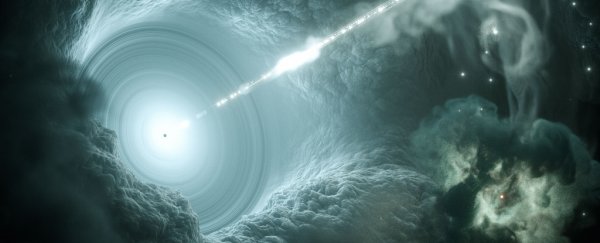Time, as far as we know, moves only in one direction. But last year, researchers found events in some gamma-ray burst pulses that seemed to repeat themselves as though they were going backwards in time.
Now, new research suggests a potential answer for what might be causing this time reversibility effect. If waves within the relativistic jets that produce gamma-ray bursts travel faster than light - at 'superluminal' speeds - one of the effects could be time reversibility.
Such speeding waves could actually be possible. We know that when light is travelling through a medium (such as gas or plasma), its phase velocity is slightly slower than c - the speed of light in a vacuum, and, as far as we know, the ultimate speed limit of the Universe.
Therefore, a wave could travel through a gamma-ray burst jet at superluminal speeds without breaking relativity. But to understand this, we need to back up a little to look at the source of those jets.
Gamma-ray bursts are the most energetic explosions in the Universe. They can last from a few milliseconds to several hours, they're extraordinarily bright, and we don't yet have a comprehensive list of what causes them.
We know from the 2017 observations of colliding neutron stars that these smash-ups can create gamma-ray bursts. Astronomers also think such bursts are produced when a massive, rapidly spinning star collapses into a black hole, violently ejecting material into the surrounding space in a colossal hypernova.
That black hole is then surrounded by a cloud of accretion material around its equator; if it's rotating quickly enough, the fallback of the initially exploded material will result in relativistic jets shooting from the polar regions, blasting through the outer envelope of the progenitor star before producing gamma-ray bursts.
Now, back to those waves travelling faster than light.
We know that, when travelling through a medium, particles can move faster than light does. This phenomenon is responsible for the famous Cherenkov radiation, often seen as a distinctive blue glow. That glow - a 'luminal boom' - is produced when charged particles such as electrons move faster through water than the phase velocity of light.
Astrophysicists Jon Hakkila of the College of Charleston and Robert Nemiroff of the Michigan Technological University believe that this same effect can be observed in gamma-ray burst jets, and have conducted mathematical modelling to demonstrate how.
"In this model an impactor wave in an expanding gamma-ray burst jet accelerates from subluminal to superluminal velocities, or decelerates from superluminal to subluminal velocities," they write in their paper.
"The impactor wave interacts with the surrounding medium to produce Cherenkov and/or other collisional radiation when travelling faster than the speed of light in this medium, and other mechanisms (such as thermalised Compton or synchrotron shock radiation) when travelling slower than the speed of light.
"These transitions create both a time-forward and a time-reversed set of [gamma-ray burst] light curve features through the process of relativistic image doubling."
Such relativistic image doubling is thought to occur in Cherenkov detectors. When a charged particle travelling at near light-speed enters water, it moves faster than the Cherenkov radiation it produces, and therefore can hypothetically appear to be in two places at once: one image appearing to move forward in time and the other appearing to move backwards.
Mind you, this doubling has not yet been experimentally observed. But if it does occur, it could also be responsible for producing the time-reversibility seen in gamma-ray burst light curves, occurring both when the impactor wave travelling through the jet medium accelerates to speeds faster than light, and decelerates to subluminal speeds.
More work is needed, of course. The researchers assumed that the impactor responsible for creating a gamma-ray burst would be a large-scale wave produced by changes in, say, density, or the magnetic field. That will need further analysis. And if the plasmas involved aren't transparent to superluminal radiation, all bets are off.
However, the researchers said, their model provides better explanations for the characteristics of gamma-ray burst light curves than models that don't include time reversibility.
"Standard gamma-ray burst models have neglected time-reversible light curve properties," Hakkila said. "Superluminal jet motion accounts for these properties while retaining a great many standard model features."
The research has been published in The Astrophysical Journal.
